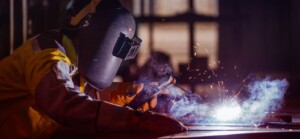Introduction:
Manual welding, especially manual metal arc welding (MMAW), is a critical skill in the welding industry. While
modern welding methods like MIG and TIG have gained popularity, manual welding remains a fundamental
technique that every skilled welder should master. This blog will explore the art of manual welding, focusing on
techniques and tips to help welders excel in this traditional yet indispensable craft.
Understanding Manual Welding:
Manual welding involves using an electrode (often a consumable metal rod) to create an electric arc between the
electrode and the base metal, generating enough heat to melt both materials. As the molten metal cools, it
solidifies, forming a strong bond between the pieces being joined. This technique is commonly known as manual
metal arc welding or stick welding.
Essential Equipment:
To begin mastering manual welding, you need the right equipment. Ensure you have a reliable welding machine
that suits the type and thickness of the materials you’s be working with. Invest in high-quality electrodes, gloves, a
welding helmet, and safety gear to protect yourself from sparks, UV radiation, and fumes.
Preparing the Workspace:
Before starting any welding project, prepare your workspace thoroughly. Remove any flammable materials, ensure
good ventilation, and secure your work-pieces to prevent movement during welding. Proper preparation ensures a
safe and efficient welding process.
Electrode Selection:
Selecting the appropriate electrode is crucial for manual welding success. Electrodes vary in composition, and the
choice depends on the type of metals being joined and the welding position. Understanding the electrode's
characteristics will lead to better results in terms of weld quality and strength.
Technique Matters:
The key to mastering manual welding lies in the technique. Start by striking the arc effectively – a skill that takes
practice. Maintain a consistent arc length and angle to achieve a stable and controlled weld pool. Position your
body comfortably and maintain a steady hand to ensure uniformity in the bead formation.
Proper Electrode Manipulation:
Learning how to manipulate the electrode is essential in manual welding. The angle of the electrode relative to the
work surface affects the weld’s penetration and profile. Experiment with different angles to understand their
impact on the weld bead.
Managing Weld Pool and Travel Speed:
Controlling the weld pool and travel speed is critical for a successful manual welding process. Proper manipulation
of the electrode and suitable travel speed prevents the weld pool from becoming too large or too narrow, which
can lead to defects like undercutting or lack of fusion.
Monitoring and Adjusting:
As you weld, constantly monitor the progress and adjust your technique if necessary. Keep an eye out for potential
defects such as porosity, cracks, or uneven beads. Regularly check the equipment to ensure the welder's settings remain optimal.
Conclusion:
Mastering manual welding, especially manual metal arc welding, is a skill that sets welders apart as true craftsmen.
This traditional technique requires dedication, practice, and a deep understanding of the materials and equipment
involved. By following the techniques and tips outlined in this blog, aspiring welders can hone their skills and
achieve exceptional results in their manual welding endeavors. So, embrace the art of manual welding and let your
creativity flow as you forge strong and enduring bonds between metals, leaving behind a legacy of precision and
craftsmanship in the world of welding.


